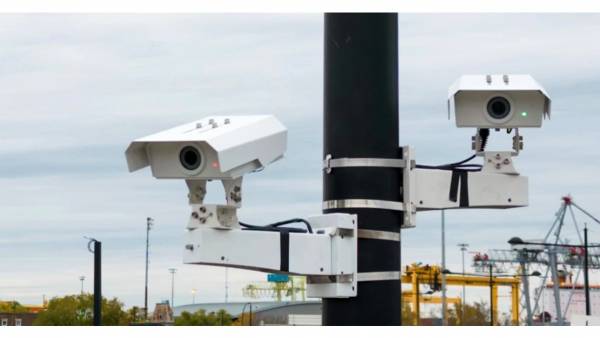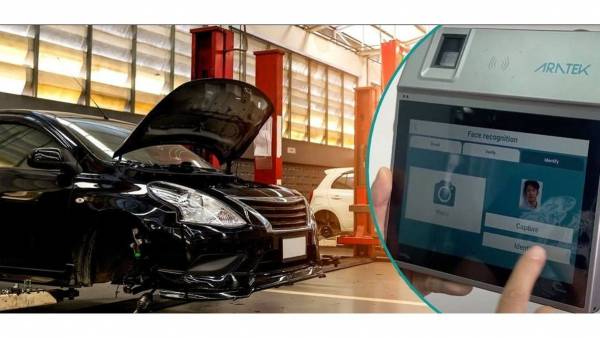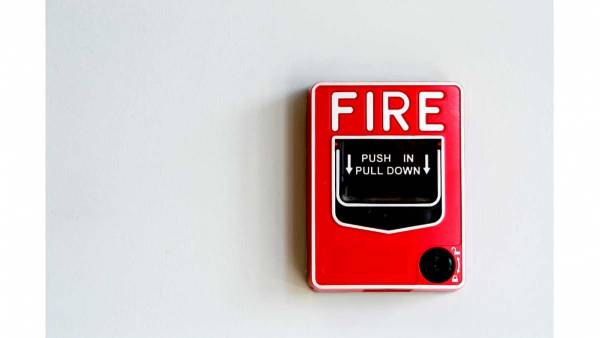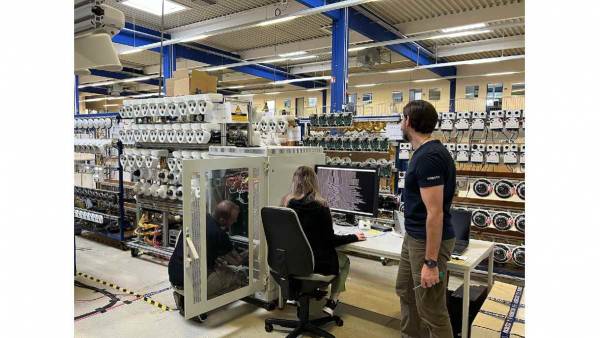By: Bosch
 In the previous installment of this article in which some guidelines are given to select a successful CCTV camera, topics such as video signal, types of lenses, sensors and image, iris, among others, were addressed. This time we will continue with other important recommendations that you should take into account.
In the previous installment of this article in which some guidelines are given to select a successful CCTV camera, topics such as video signal, types of lenses, sensors and image, iris, among others, were addressed. This time we will continue with other important recommendations that you should take into account.
Reflection of the scene
It should be kept in mind that the camera (like the human eye) processes reflected light – light that is reflected off objects and people in the field of vision.
Light hits the object and bounces off it. The light then passes through the lens, hits the image sensor, and creates an image. Different materials reflect light at different speeds. The chart below shows some areas or objects and their corresponding reflection values – or the percentage of light reflected off them.
The amount of lighting available, along with the sensitivity of the camera, represent crucial information when choosing a camera for your application. Lighting and sensitivity have an inverse relationship: that is, more light requires less sensitivity and with less light, greater sensitivity is required.
Resolution
Resolution is the extent to which you can observe the details in an image. For analog systems, this is typically measured in Television Lines (TVL). The higher the resolution, the better the definition and clarity of the image. The camera "scans" an image on a series of lines operating horizontally. Each horizontal line is composed of a number of elements. Once the first line is scanned, you continue with the second line and so on.
Resolution is a measure of the number of both lines and the component elements that make up each line. In a CCD camera, the resolution has a direct relationship to the number of pixels in the CCD image sensor.
Resolution measurements measure the number of horizontal lines a camera uses to produce an image. Horizontal resolution measures the number of elements that make up each horizontal line. Vertical and horizontal resolutions typically yield a ratio of 3:4 (e.g. 600 vertical lines for 800 elements on each line).
The resolution of the CCTV camera is usually in a range between 380 and 540 TVL. The higher the resolution of the camera, the more details will be visible (since the lines are closer and more elements may exist in each individual line). The low resolution of the cameras produces images with less detail.
Other important factors
In addition to the primary considerations when selecting a camera, there are other factors that affect image quality:
• Signal-to-noise ratio
• Automatic earnings control
• Automatic shutter
• Backlight compensation
• Electronic and manual adjustments
• Advanced Digital Signal Processing (DSP)
Automatic Shutter
Auto shutter control adds greater flexibility to the camera by controlling the quality of light. Lighting sources are composed of different
wavelengths of light.
For example, sunlight is practically a pure form of white light each wavelength is present in reinforced equivalent quantities. However, in other kinds of light (fluorescent, home, lamps, street lights with sodium vapor,
etc.), wavelengths are unmatched. These differences can be extreme, resulting in significantly degraded image quality.
While the human eye is able to compensate for many of these differences, a color camera needs a specialized circuit. Automatic shutters compensate for changes in light quality. In this way, an outdoor camera with automatic shutter control can produce accurate images in a parking lot during the day, as well as under artificial lighting.
Shutter is a function of the camera. Basic cameras display or "observe" an image at a rate of 60 times per second (the speed of a 1/60 shutter). The digital signal processing technology in the camera has been improved. Therefore, this circuit can analyze the video signal and if necessary change the sample rate of the image to up to 100,000 times per second. This allows darker images to be subjected to a greater amount of "digital" sampling, using existing light and thus producing better images.
Backlight Compensation (BLC)
Backlight is the light behind the object of interest in a scene. This can be the biggest problem, especially in cameras that will need to be adjusted on some occasions to keep the brightness of the background at acceptable levels.
Think about a camera pointing toward a door that sits at the end of a long, dark corridor. When someone opens the door and walks down the corridor, the camera will try to compensate for the sudden glow coming from outside. The result will be that the person in the corridor will appear as a silhouette and the details will be lost in the "shadow". In extreme cases, no details may be distinguished. The cameras must have a backlight compensation to save this situation.
The backlight compensation is composed of the camera circuit that reproduces the scene and assumes that the objects in focus are the objects of interest, and that the light levels must be optimized for these objects. Extremely high backlight levels can be selectively turned off while maintaining optimal levels on objects of interest.
Manual and electronic settings
Like any electronically sophisticated component, cameras require periodic adjustments to maintain high performance. These adjustments must be made manually in most cases. Newer cameras allow adjustments to be made electronically from remote sites – and the benefits are clear:
• Immediate corrections if necessary.
• Adjustments are made instantly from a central location.
Consider a camera mounted on a parking lot pole. A technician can make adjustments to this camera without worrying about the weather, and without having to climb a ladder or use a crane. Thus, you can save valuable time, decrease the chances of accidents and there are fewer interruptions in operation.
For example, Bosch's Blinx Bi-Directional Communication technology uses a conventional CCTV coaxil, a UTP (unshielded twisted pair) and video transmission links via fiber optics to communicate information to and from the camera. Blix technology embeds control and configuration commands into the video signal, enabling many features that used to require direct access to the camera or separate wiring to work on a video cable.
Advanced digital signal processing
The first attempts to develop video cameras with a resolution and sensitivity as good as the human eye, in theory the main objective, were not very successful. This happened because the eye presents a three-dimensional image to the brain, which uses a high degree of parallelism in image processing. The brain's ability to interpret image content at the same time contributes to intelligent and sophisticated image optimization.
The application of digital technology within the camera comes from the need to improve image quality, sensitivity and dynamic range. DSP technology and the series of advanced CCD chips produce an exceptionally high number of gray levels, resulting in dynamic range and detail reproduction within high-quality images in high- and low-light scenes.
Clearly, the performance of the camera control includes the flexibility of handling the camera through the monitor screen itself, which is critical when making a choice.
The image quality of a CCD camera is directly related to the number of gray levels that can be processed, which are controlled by the DSP architecture. For example, a 1-bit processor can generate an image similar to that produced by an array printer, while a 4-bit processor provides 16 levels of gray to produce a better image.
Most security cameras use 10-bit processors and are capable of producing images with 1024 levels of gray, delivering relatively smooth variations from light to dark. Dinion cameras employ 15-bit digital signal processing, which provides a 32-fold increase in the number of gray levels and color accuracy compared to a 10-bit DSP, producing what the eye interprets as virtually continuous variation of the gray level.
This results in exceptionally accurate image reproduction with a wide dynamic range and vivid colors over a wide spectrum.
Wide dynamic range
Roughly defined, the camera's dynamic range is the difference between the maximum and minimum level of acceptable signal levels. If part of a scene is poorly lit, there is a high chance that there are not enough photos coming from that area to be converted into a meaningful electronic signal.
Detail in the dark will not be "observed" by the camera. Conversely, if a part of the scene is highly lit (for example, sunlight coming through a window), the image of that area may appear discolored. In the worst-case scenario, the scene can, and usually does, contain areas with extremely high and low lighting levels.
Dynamic range is the imaging chip's ability to convert light into information. The wider the dynamic range of the camera, the better the camera's ability to cope with these extreme contrasts of light. To implement the XF-Dynamic feature, the Bosch 15-bit Dinion DSP uses a function known as a control
histogram to achieve more detail in the image by amplifying per-minute variations in lighting.
The illumination of each pixel in a ccd-obtained scene is recorded in a luminosity histogram that organizes the pixels into 32,767 levels of gray – in a range ranging from black to maximum brightness in a scene.
The camera transfer function (the curve defining the output as a function of the input), instead of being a simple straight line like a normal camera, automatically increases strongly in regions with high information density and with lower force in regions with lower information density.
This creates a more evenly distributed luminosity histogram at the camera output. Low-contrast scenes are typically characterized by a very high pixel count at only a few levels of gray. In such scenes, the histogram reduces the number of pixels at these gray levels. At the same time, the pixel count is increased at other levels (less well represented) to adjust the contrast over the entire image and thus highlight the greatest amount of detail.
Smart exposure
Another aspect of the wide dynamic range allowed by the XF-Dynamic feature of the DinionXF is that it offers a significant advantage over the alternative of "dual exposure technology" used in other security systems with cameras.
Here, a long accumulation time exposure of about 1/50 sec. (for PAL) or 1/60 sec. (for NTSC) is used for the dark areas of a scene, and a short exposure of about 1/1000 second or less is used for bright areas. A "clever" combination of these two exhibitions is then made in principle, this should possess the best of both worlds, accentuating all the details of the scene without overexposures of the bright spots.
In practice, the optimal combination is difficult to achieve and especially compromises any change between day and night scenes, resulting in less than optimal exposure and degraded image quality.
Frame integration
Some cameras include frame integration techniques to try to adjust the problems related to obtaining clear images in low light conditions. A slower shutter speed is used to capture enough light in the darker areas of the scene. Bosch increases the sensitivity of the DinionXF by improving the time of accumulation of the image. By reducing the shutter speed, the build-up time and sensitivity are increased even a little more.
Conventional security cameras are limited by the rate of frames of
Monitoring surveillance at a maximum of 1/50 second (or 1/60 second) to create a video-compatible output signal. The DinionXF fixes this problem by decoupling the accumulation of images from the video through a feature called SensUp.
This markedly improves the effectiveness of sensitivity. The accumulated image is stored in memory and displayed every 1/50 seconds (or 1/60 seconds) to create a compatible video output signal, with the memory constantly updated every year.
1/5 seconds. The advantage of the SensUp is that instead of working in steps, like most cameras, it uses a continuous adjustment of the shutter speed for smooth control of the video level. This makes it more effective in situations where artificial lighting is not available.
Dynamic Noise Reduction
Noisy scenes recorded can dramatically increase the size of digital files (which are usually archived over time on a remote hard drive). In extreme cases, noisy scenes can reduce the period of the file, for example, from a month of video to no more than a week.
Electronic noise is caused by a number of sources, including attenuation
of cables, thermal effects, and over-amplification. It is worth clarifying that the camera itself can be a source of noise. Some cameras include Dynamic Noise Reduction (DNR) to improve image quality by reducing or canceling electronic noise, especially in low-light conditions.
The DNR system in the Bosch DinionXF camera eliminates noise by comparing images produced over time. A powerful algorithm developed for the 15-bit DSP processor then performs a pixel-by-pixel audit of the images and any small or random changes that may be a symptom of noise are automatically removed from the scene (see example below).
Signal to Noise Ratio
The Signal to Noise ratio (s/n ratio) is the ratio that indicates the level of video signal present in the image. Noise in an image decreases the definition of the image. The unit to express this ratio s/n is the decibels (dB), but it can also be expressed as a ratio. A signal-to-noise ratio of 40 dB is equivalent to a 100:1 ratio, which means that the signal is 100 times the noise level.
Moreover, the noise is 1/100 of the signal. At a signal-to-noise ratio of 20 dB, the noise is 10% of the signal and will produce an unacceptable image.
There are many sources for noise, including poor circuit design, heat, overamplification, external influences, and automatic gain control, as well as transmission systems such as microwaves and infrared. The signal-to-noise ratio is an important measure of video quality: the larger the signal-to-noise ratio, the better the quality of the image generated by the camera.
Auto Contrast Adjustment
Fog, haze, haze, and glare significantly reduce image contrast and can make recognition (or even detection) nearly impossible. Advanced 15-bit DSPs processing power provides significant contrast improvements by increasing the camera's dynamic range range.
Using the XF-Dynamic Auto Black function, the DinionXF camera dynamically adjusts lighting levels in scenes to reduce darker areas to (almost) black.
This feature improves contrast in images obscured by "veils" of haze or where contrast is reduced by fog or haze. The Auto Black function is the most effective in situations within an environment, such as a nightclub with low light and cigarette smoke.
Motion Blur Image Reduction
In most images taken from recording moving objects, details often lose clarity given the relatively slow shutter speed of 1/50 sec (or 1/60 sec.) used in standard CCTV cameras. This makes the identification of individuals and vehicle license plates, for example, difficult and even impossible.
The solution is to increase the shutter speed to freeze the image, which can only work as long as there is enough light. Increasing the shutter speed means increasing the level of illumination or lens aperture to compensate for short exposure. Once the light level decreases and the lens is fully open, Automatic Gain Control (AGC) can be activated to provide greater magnifications.
However, when it has reached its limit, the image simply degrades until it becomes unusable. The Bosch DinionXF camera can obtain accurate moving images over an extended period of time by combining features that work together to maintain optimal performance. By changing the camera mode to the default Shutter Mode, you can set the speed to a default value (for example, 1/250 sec.).
As long as there is enough light in the scene for Auto Iris and AGC lens control to produce a full video signal, the shutter speed will remain fixed at the default value. Only when the light fails, the shutter control will be responsible for reducing the shutter speed until the default value is reached. Motion blurry images will fall back on this lower shutter speed, but this is preferable to losing the video signal altogether.
This default shutter system provides videos without blurred images by movement for as long as possible, and at the same time allows you to capture images in all kinds of light conditions.
Cable Compensation
New processing techniques have allowed camera manufacturers to bring the resolution of color cameras up to 540 TV lines (TVL). However, 540 TVL can only reach its full benefit if you use short cables; otherwise, attenuation in the cable reduces the observed resolution.
To eliminate the need for additional amplifiers to compensate for the loss of these cables, many Bosch cameras have the cable compensation option, which adapts the camera's output video to minimize the loss caused by the cables. This function reaches high-frequency components in the output signal that are responsible for the finer details in the image – which compensate for large high-frequency losses in the cable.
They also compensate for cable resistance by amplifying DC power and low-frequency components that are responsible for maintaining proper synchronization of bright images. You can select cable compensation directly on the display of the camera screen. It can be determined in three types of coaxial cable with equalization levels that are adjustable within a wide range: it can compensate for cables with a length of up to 2000 meters.
Only Bosch cameras with built-in cable compensation are capable of
generate a full resolution of 540 TVL for recorders and monitors in one terminal.
If you want more information about CCTV you can enter www.boschsecurity.com
























Leave your comment